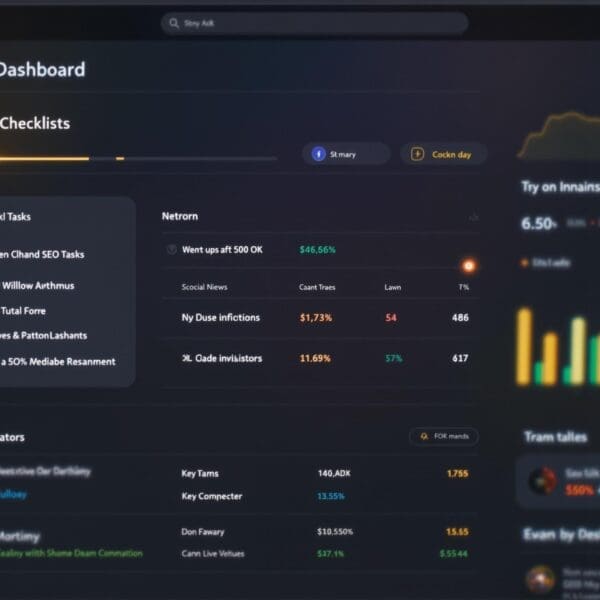Wondering how to improve your website’s SEO and gain positions in Google search results? This article tells you all about backlinking – that important hyperlink for SEO – and its decisive role in your netlinking strategy. Find out how to acquire quality backlinks, optimize your link profile and boost your domain’s authority, all to attract more qualified traffic to your pages.
Table of contents
ToggleUnderstanding backlinks and their role in SEO
A backlink – also known as an inbound link – is a hyperlink pointing from one website to another. It is integrated into the content and directs to another site or domain.
Backlinks play a key role in SEO. They influence various aspects of online visibility. It’s important to understand these impacts in order to optimize an effective SEO strategy.
- Improved ranking: Backlinks, considered votes of confidence by search engines, contribute significantly to improving a website’s ranking in search results; this increases its visibility.
- Ease of discovery: Creating backlinks makes it easier for search engines to discover your website. They can then explore and index the content more quickly. This is important for good SEO positioning.
- Generating referral traffic: Backlinks can generate qualified referral traffic to the website. They direct users interested in a specific topic to a relevant page – increasing engagement and conversions.
- Increased domain authority: Acquiring quality backlinks helps increase a website’s domain authority. This is a metric used by SEO tools to assess a site’s credibility and competitiveness in relation to its competitors.
- Reinforcing brand awareness: Backlinks increase brand awareness online. They expose the website to a wider audience and strengthen its web presence through mentions and recommendations from external sites.
In conclusion, backlinks are a pillar of SEO. They positively influence a website’s ranking, discovery, traffic, authority and reputation.
Evaluating the quality of a backlink is based on several criteria. Google takes into account the popularity of the source site, the relevance of the content and the link anchor used. A backlink from a site with a high profile is more valuable – as it is perceived as a sign of quality and trust by search engines, which further reinforces the authority of the receiving website.
Strategies for acquiring quality backlinks
Here’s a comparison of backlink acquisition methods: For a more in-depth look at the subject, consult this complete guide to backlinks.
| Method | Advantages | Disadvantages |
|---|---|---|
| Guest Blogging |
|
|
| Sponsored Articles |
|
|
| Netlinking |
|
|
To identify reliable websites for backlinks, it’s important toanalyze their link profile using SEO tools. These tools can be used to evaluate link quality.
Black Hat SEO practices can damage the user experience and lead to penalties from Google, so adopt a respectful approach to Google’s guidelines by favoring White Hat SEO. It’s crucial to respect Google’s guidelines and avoid manipulative techniques aimed at misleading search engines – as these can negatively impact your SEO and the trust users place in your site.
Types and technical characteristics of backlinks
Dofollow vs Nofollow: strategic choices
Dofollow links are important because they transmit authority from one site to another. This helps improve the linked site’s visibility in search results. Please note that these are the default links – unless they are manually converted to nofollow.
There’s no hard and fast rule about the ideal ratio between dofollow and nofollow links. Most SEO and netlinking professionals often recommend a ratio of 60:40 or 70:30. However, search engines focus more on the quality and relevance of links than on a specific ratio, so it’s important to prioritize quality links.
HTML integration and anchor optimization
It’s difficult to give precise advice on how to structure a <tag effectively at>, as information on this subject is limited in web search results.
Before the Google Penguin update in 2012, anchor text was an important factor in a website’s ranking. Exact match anchor text is the simplest and most powerful type; however, it must be used sparingly toavoid being penalized by Google – a penalty that can significantly harm your site’s visibility.
Netlinking and creating relevant networks
Improving your SEO through backlinks requires a methodical approach, including mapping your digital environment and analyzing your competitors’ backlinks. Here are some practical solutions to these two sometimes complicated problems.
Mapping your digital environment :
Mapping your digital environment involves identifying and visualizing the key players in your sector, the communication channels used, and the relationships between these elements. This helps you better understand your positioning and identify opportunities for improvement. To do this :
Use mind mapping tools: Software such as XMind or MindMeister makes it easy to create mind maps to structure your information.
Analyze your online presence: Identify the platforms where your company is active (website, social networks, directories) and evaluate their performance.
Study your competitors: Locate the major players in your sector, analyze their digital strategy and identify the channels they use.
This approach will help you visualize your digital ecosystem, detect gaps and develop a more effective SEO strategy.
Identify key indicators when analyzing competitor backlinks:
Analyzing your competitors’ backlinks is crucial to understanding their netlinking strategy and uncovering opportunities for your own site. Here are the indicators to keep an eye on:
Total number of backlinks: Evaluate the number of links pointing to the competitor’s site to measure its popularity.
Quality of referring domains: Analyze the authority of sites linking to your competitors. Tools like Ahrefs or Moz can provide this information.
Diversity of link sources: A variety of referring domains indicates a robust netlinking strategy.
Anchor text used: Examine the keywords used in link anchors to understand which themes your competitors are positioning themselves on.
New and lost backlinks: Track the evolution of links acquired or lost by your competitors to adapt your own strategy.
By monitoring these indicators, you can identify link-building opportunities, understand your competitors’ strengths and weaknesses, and adjust your SEO strategy accordingly.
By combining a precise mapping of your digital environment with an in-depth analysis of competing backlinks, you’ll be able to develop a more effective SEO strategy tailored to your market.
Optimizing the SEO impact of backlinks
Quality criteria and key metrics
Trust Flow and Citation Flow are metrics developed by Majestic SEO. Trust Flow measures the quality of links pointing to a website, while Citation Flow evaluates the quantity of these links.
Citation Flow is no guarantee of a site’s reliability or relevance. Indeed, it can happen that a site has a high Citation Flow thanks to links from unreliable sites or even spam. It’s essential to combine Citation Flow with Trust Flow – to get a more complete picture of a site’s performance.
Link profile audit and cleanup
A regular audit of your backlink profile is essential to maintain and improve your website’s SEO. This helps identify low-quality or toxic backlinks that could harm your search engine rankings. A number of specialized tools are available to help you carry out this audit and clean up your link profile.
Recommended tools for auditing and cleaning backlinks :
- Ahrefs: Provides in-depth analysis of your backlink profile, including number of backlinks, referring domains and link quality assessment.
- SEMrush: Provides comprehensive tools for auditing your backlinks, detecting toxic links and monitoring the overall health of your link profile.
- Moz Link Explorer: Gives you an overview of your backlinks, evaluates the authority of referring domains and identifies potentially harmful links.
- SEO SpyGlass: Includes a penalty risk audit feature, automatically detecting toxic backlinks and helping to protect your site from Google penalties.
- Google Search Console: Provides a list of backlinks detected by Google, making it easy to identify suspicious links and submit disavow files.
- SEOptimer: Offers a link audit and defective backlink removal service, including a complete analysis of every backlink linked to your website.
Using these tools will enable you to identify poor-quality links, contact webmasters to request their removal or, if necessary, disavow these links with Google in order to preserve your site’s reputation and ranking.
Monitoring tools and resources
Monitoring backlinks is essential for evaluating and improving a website’s SEO strategy. These links, coming from other sites pointing to yours, directly influence your positioning in search engine results. To monitor, analyze and optimize your backlink profile, here’s a list of tools for tracking the backlinks pointing to your website. Here’s a list of tools for tracking backlinks.
- Ahrefs: Renowned for its comprehensive database, Ahrefs offers detailed backlink analysis, including information on referring domains, link anchors and link profile evolution.
- Semrush: This versatile tool offers Backlink Analytics functionality for evaluating and comparing link profiles, identifying new opportunities and tracking lost links.
- Moz Link ExplorerMoz offers an overview of the quality and quantity of backlinks, with key metrics such as Authority Score, helping to understand the impact of links on SEO.
- Majestic: Specializing in link analysis, Majestic provides indicators such as Citation Flow and Trust Flow, assessing the quantity and quality of inbound links respectively.
- SE Ranking: This tool offers a Backlink Checker that evaluates a site’s link profile, identifies link acquisition opportunities and refines off-page strategies.
- Linkody: Designed for tracking and managing netlinking campaigns, Linkody continuously monitors backlinks, analyzes link profiles with key metrics and detects competitor strategies.
- SEOptimer: Offering a backlink checker, SEOptimer lets you see all the links pointing to a site or page, as well as key domain metrics.
- Google Search Console: A free service from Google, it lets you check whether a site is indexed, optimize its referencing and consult the list of pages with backlinks.
Using these tools, webmasters and SEO specialists can effectively monitor backlinks, identify opportunities for improvement and boost their website’s online visibility.
Mastering backlinks is an important part of effective SEO. Focus on link quality, evaluate your profile and optimize your anchor texts, because your visibility is at stake. Act now to propel your site to the top of the search engines.
Frequently asked questions about backlinks (FAQ)
What tools can you use to analyze your competitors' backlinks?
To analyze competitors’ backlinks, tools like Majestic are important. This tool enables you to analyze your web presence, understand how links fit together and identify sites that are talking about your company.
Majestic’s Site Explorer function generates backlink data, with key indicators such as Trust Flow and Citation Flow. A backlink analysis tool helps you assess the competition, identify new link opportunities and align your strategy accordingly.
How do you structure an "a" tag in HTML?
The <a> HTML tag, or anchor, is used to create hypertext links. Its basic structure includes the opening of the tag, the href attribute specifying the link destination, the link text, and the closing of the tag.
The href attribute is essential as it defines the target URL of the link, whether absolute or relative. Other attributes, such as target (to specify where to open the link) and rel (to define the relationship between pages), can also be used to enhance the tag’s functionality.
What signals indicate a toxic link?
Toxic links are low-quality inbound links that damage a website’s SEO. They can weaken SEO, lead to algorithm penalties and a drop in organic traffic.
Telltale signs include links from irrelevant websites, spammy sites, fake links, dubious sources, an unjustified rise in backlinks and irrelevant anchors. It’s important to analyze backlinks regularly to identify and disavow toxic links.
When should I use Google's disavow tool?
Google’s disavow tool should be used with caution and only if a site is subject to manual action due to artificial links, or if such action is feared due to paid links or other link schemes that do not comply with Google’s rules.
It’s vital that a considerable number of artificial, low-quality or spam links point to the site, and that these links have triggered or are likely to trigger manual action. Before disavowing, it is advisable to remove as many poor-quality links as possible from the web.
Which features should be prioritized in analysis tools?
Features to prioritize in backlink analysis tools include link profile analysis (domain strength, number of backlinks, etc.) and monitoring link evolution over time. It’s also important to identify link-building opportunities and detect toxic links.
Tools should also enable analysis of anchor text, domain types and countries of origin of links. In fact, other features such as follow/nofollow attribute analysis and detailed reporting are also important, enabling you to see the big picture and fine-tune your strategy.
How do you map your digital environment for netlinking?
To map your digital environment for netlinking, it’s essential to analyze your own website and identify relevant websites for establishing partnerships. This mapping enables you to visualize the ecosystem in which your site operates and identify opportunities for quality inbound links.
Key steps include analyzing your website, identifying competitors, finding potential partner websites and analyzing these sites (domain authority, traffic, etc.). You also need to establish lasting relationships and use analysis tools to track the evolution of your backlinks.















